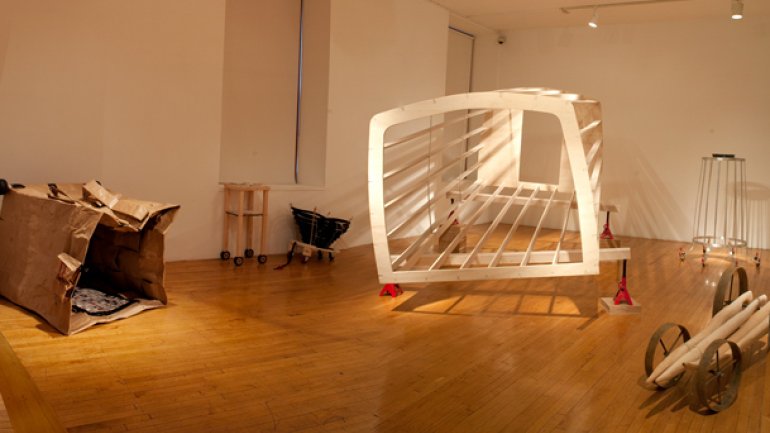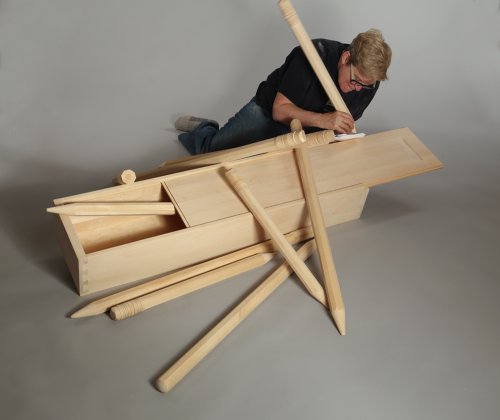Driving the Point
From American Craft Inquiry: Volume 2, Issue 1
Every time I visit an art museum and see an exhibition showcasing an artist’s body of work, what strikes me is the artist’s commitment. Specifically, I am struck by the seemingly unwavering commitment to an idea or series of ideas. Not just fleeting notions, but ideas that have been thoroughly explored through a creative process and technical experimentation to ultimately manifest as masterful works of art. Characteristics such as tenacity, curiosity, perseverance, and passion are the fodder that artists utilize to explore ideas from concept to completion for art’s sake. In the arts there has been a cultural shift from the valuation of masterpieces to concepts expressed through experience and interaction. This has led many artists to the incorporation of social practice methodologies. Often the content is skewed toward the confrontational to draw attention to particular issues relevant to our society, culture, and community. Yet sometimes creative expression makes its impact through the facilitation of interactivity with the general public. The question of leveraging one’s personal creative practice for the greater good can seem like an overwhelming, lofty ambition. Yet there are artists who are driven by an inner calling to have meaningful impact through their work. Beth Ireland is one inspiring example of someone who is not only motivated to make, create, and explore for sustenance and personal fulfillment, but also by her drive to share with others.
Ireland is multi-disciplinary artist – a woodworker, sculptor, carpenter, book artist, teacher, and social activist through craft. Though she is known mostly within the world of woodturning, there is much more to her repertoire. For 34 years she ran her own woodworking company in a Boston neighborhood, collaborating with architects and interior designers to build custom-made cabinetry, architectural woodturning, and carvings. She taught herself how to turn on a lathe to replicate architectural columns and create a niche business. Her interest in taking to the road increased as her turning skills became expert and she was regularly invited to demonstrate to groups and woodturning clubs all over New England. An astute business woman, Ireland strategically built multiple streams of income to provide her opportunities to work with the materials she loves.
“I have always felt that motion leads to ideas. Even if I just go down to my shop and clean, I find some project that might have been cast off years ago and now I see the possibility. I love the idea that each day is like going to the casino, this might be the day where a jackpot idea happens, and yet the day started as any other. I find that exciting.” – Beth Ireland
In 2005, she began working with a high school teacher in Derry, New Hampshire, to develop lessons that would prepare students who were not college-bound to make a living as woodworkers. With the help of a colleague, Ireland developed the Creative Enterprise Curriculum and once a week made the trek from Boston to Derry to teach it. The program’s success made her wonder, “what if this were bigger?”
In 2007, she decided to pursue a master’s of fine arts at Massachusetts College of Art and Design. There she plunged into making sculpture and conceptual work. This necessitated developing a writing practice to explore her ideas, fears, joys, and aspirations. She began to create sculptures, intimate dwellings, tiny houses, and spaces for contemplation. Yet it was a course on relational aesthetics that challenged the context of creative practices that awoke her to new possibilities. The prompt in this course was for artists to question the practice of working in the privacy of their own workshops and consider “What is possible if you take your creative practice out into the world? What would you do if you were to take your creative practice to a public realm? What would it be?” For Ireland, this was a seminal moment, an exciting question that helped her conclude that teaching is just as creative an act as making something out of wood.
In her own words, “My work falls in a quirky realm of object making. I have always felt there is not enough craft in art, and not enough art in craft. My work falls in the realm between. I love to teach and find it to be an art in itself.” She worked out a way to combine all the elements of her work into something that would enable her to take her creative practice to the world in a more intentional way.
Percolating Ideas
The idea of a portable living space began to take shape through a compelling body of work during graduate school that landed Ireland a series of prestigious residencies where she was provided with the time and space to delve deeper into her work.
These included the International Turning Exchange in Philadelphia, the Windgate Residency at SUNY Purchase, and the Windgate Residency at Indiana University of Pennsylvania. The realization that many of her fellow sculpture students didn’t know how to use tools and power equipment was and still is very troubling to her because, in essence, they have ideas but have no skills to help bring these ideas into the material realm. It is precisely the ability to use tools and build things that has empowered her and opened every door in her career. She felt called to teach anyone willing to learn how to use the equipment in the woodshop and developed a short-format tutorial through which individuals can make an object using tools to cut, join, and shape wood.
While interviewing Ireland in 2016 for a book I co-authored (Making Good: An Inspirational Guide to Being an Artist Craftsman, published by Schiffer books in 2017), I began to understand how hard she has worked to overcome the many barriers, including discrimination because of her abilities as a female woodworker and harassment in the workplace in order to succeed. Some of the worst experiences came from having had her tools stolen by a co-worker and having been set up to take a fall on a construction site by another. This caused a very serious injury to her back from which she thankfully recovered. It’s her resilience and willfulness that triumphed over these transgressions. Driven to resist discrimination, her personal protest is to persevere and follow through with her mission.
Turning Around America
Ireland’s goal was to travel for a year through the United States and teach as many people as she could to make simple objects in wood. A combination of her experiences, such as realizing herself as a professional craftsman and educator, committing to the prompts presented in the relational aesthetics course in graduate school, and taking the time to incubate ideas while participating in artist residencies resulted in the Turning Around America project. She began by outfitting a van with a functional workshop and living space. Sufficiently equipped for travel around America, with the capacity to live and carry tools and teach out of the vehicle.
In order to make this project public she created a website with a blog and a Facebook page (Beth Ireland) to document the project from its beginning stages. She then contacted woodturning groups and offered to come demonstrate for them for a fee and asked them to connect her to school and community groups for whom she could teach. Before even taking to the road there were nine workshops on the schedule and nine destinations marked on her map.
As Ireland began posting to the blog about her progress, friends and woodturners began contributing to her efforts by donating funds to purchase materials and pay for travel. This generosity allowed her to often teach for free. A former student from the Creative Enterprise program connected her to an elementary school in Buffalo, New York. Ireland soon found herself teaching second graders how to use files, clamps, and glue to create their very own whistle in an hour. The Turning Around America project went viral within many school systems, and soon the requests for her to visit one school after another were steadily streaming. In one year, the Turning Around America project travelled 30,000 miles and Ireland taught woodworking skills to 3,000 individuals who made a tool, whistle, or pen.
Inclusion
Today, as a fully emerged artist, Ireland is adept at addressing resistance from closed-minded individuals. She has supported many people, especially women, who want to learn how to work with tools to manipulate wood. She has encouraged women to overcome their fears by demystifying the actual process of working with power equipment. Three years ago, she asked me if I would support a workshop specifically for women who want to learn woodturning at Peters Valley School of Craft. I said yes! She seemed surprised that I wasn’t concerned about the potential controversy of the matter. It isn’t that I wasn’t concerned, but I was ready to handle any questions about exclusion that might arise. I felt comfortable the workshop would fully enroll, which it did, and it was a great success. I also knew we had plenty of other workshops to offer that were open to both women and men. Our goal as a school was to support Beth Ireland in her efforts to help expand the field and the culture of wood turning as an art form to women and younger generations.
Admittedly, offering a gender-specific course is exclusionary, but the tactic is inclusionary. People who work on diversity, equity, and inclusion understand that for folks who are used to standing on the sidelines, it often takes an intentional invitation and welcoming environment to encourage them to step into it. It takes a willingness to negotiate complicated conversations, and differences of opinion in the name of inclusion, and it works. You simply have to be prepared to take the heat and move through it with determination.
Those who work on behalf of diversity, equity, and inclusion understand that the efforts need to be intentional and unapologetic. I am happy to see that the American Association of Woodturners now has a Women in Woodturning Committee (not a chapter of the AAW) and that despite some of the pushback these talented women are doing their part to teach.
Much of Ireland’s success stems from her ingenuity and charismatic style of teaching, which is deeply rooted in a curiosity about what is possible when people are provided with the tools, materials, and good instruction required to develop their abilities. Her personal experience of making a life and living as a maker has culminated in her confidence to pursue ideas to their fullest extent. In doing so, she has inspired so many people along the way, while fulfilling her personal mission to empower people through the act of teaching them to make. Sometimes it takes one or a series of radical acts to get to the heart of the matter.
View Issue Three purchase issue


